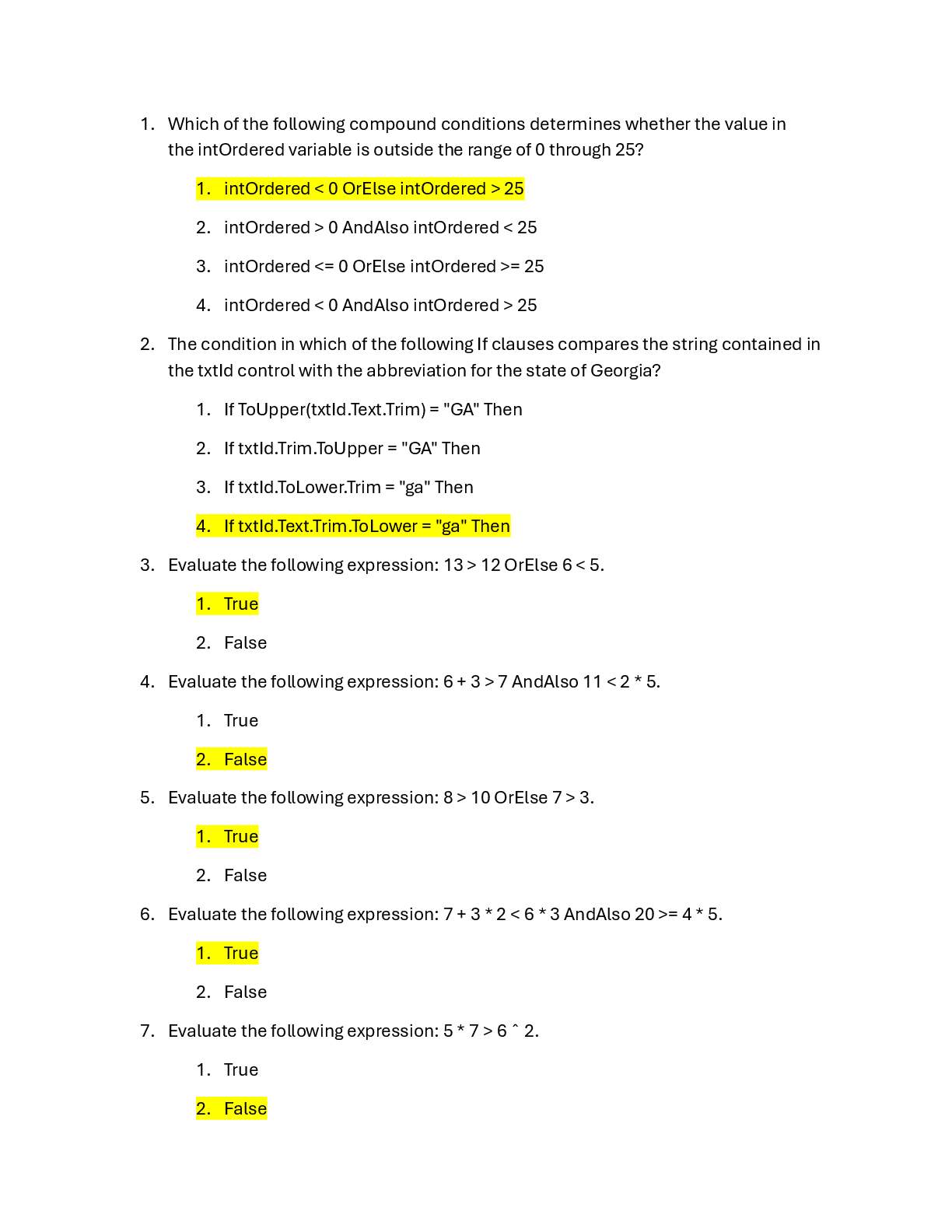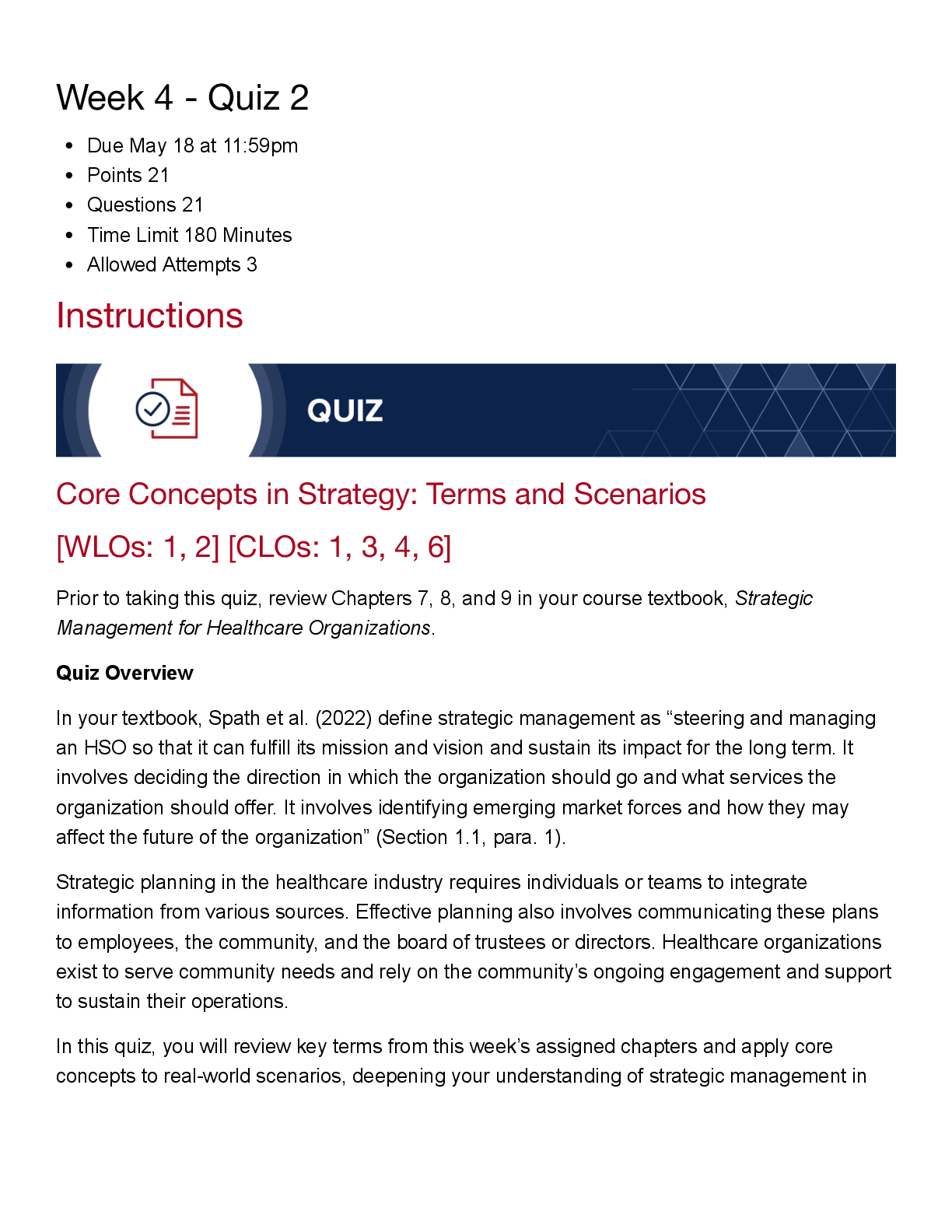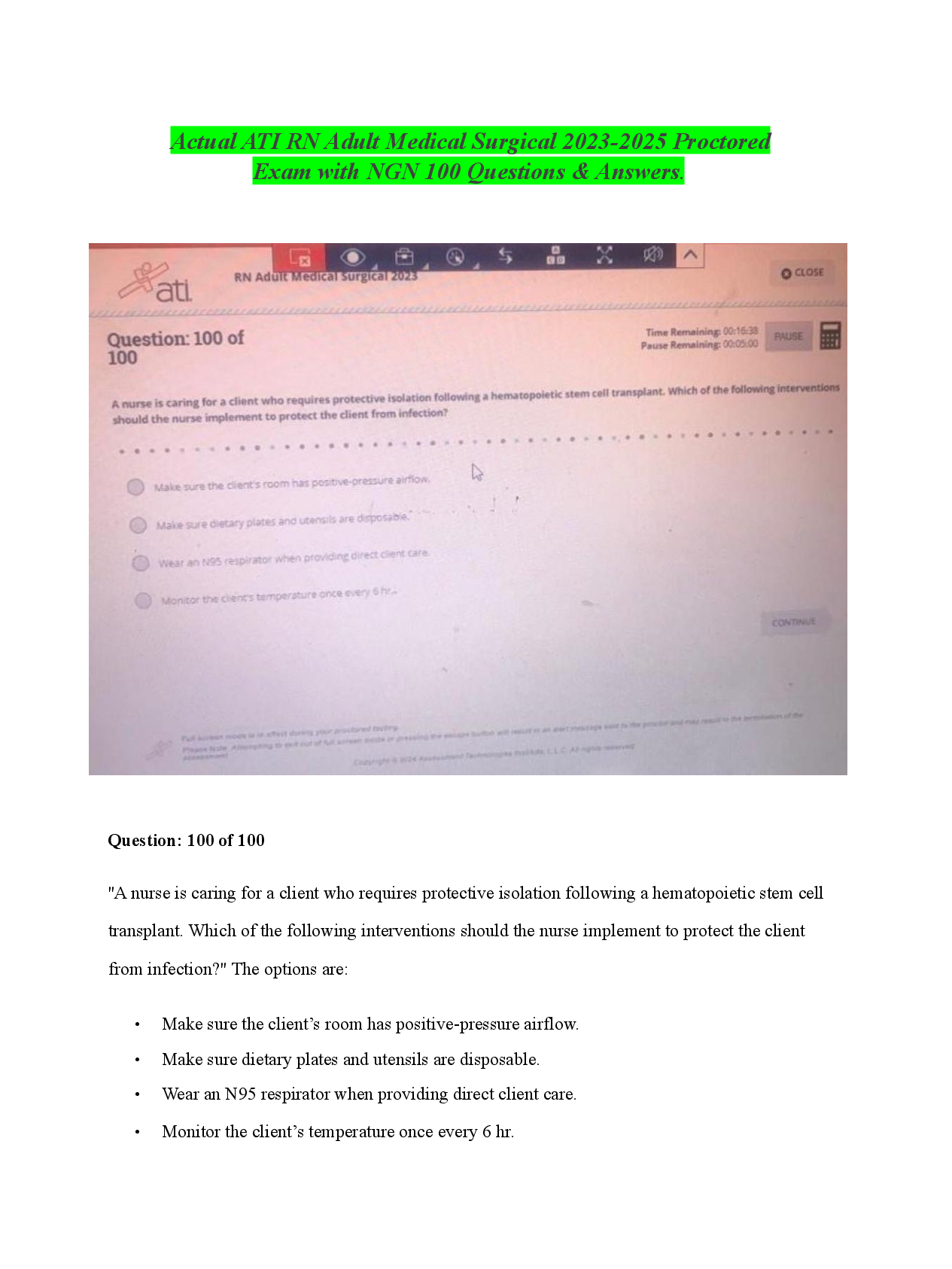ASTRO 207 Midterm 1 Exam - Questions with Verified Answers
Document Content and Description Below
ASTRO 207 Midterm 1 Exam - Questions with Verified Answers The amount of time between successive passes of any given star across the meridian is: A) 365.25 days B) 12 years C) 23 hours, 56 minutes D ... ) 26,000 years E) 24 hours When someone on Earth observes the Moon in the first-quarter phase, someone on the Moon facing Earth observes Earth in the: A) new Earth phase B) crescent Earth phase C) third-quarter Earth phase D) full Earth phase E) first-quarter Earth phase What is a circumpolar star? A)a star that always remains above your horizon B) a star that is close to the north celestial pole C) a star that is close to the south celestial pole D) a star that is visible from the Arctic or Antarctic circles E) a star that makes a daily circle around the celestial sphere When we see Venus in its full phase, what phase would Earth be in as seen by a hypothetical Venetian? A) third quarter B) first quarter C) waning crescent D) full E) new Suppose you live at latitude 40 degrees N. Which of the following describes the conditions that make a star circumpolar? A) stars are circumpolar if they have declination > +50 degrees B) no stars are circumpolar at this latitude C) stars are circumpolar is they have right ascension > 6 hr D) stars are circumpolar is they have right ascension < 6 hr E) stars are circumpolar is they have declination > +40 degrees On the 1-to-10 billion scale, about how far is it to the nearest stars besides the Sun? A) 400 kilometers B) 1000 kilometers C) 4 kilometers D) 4,400 kilometers E) 10,000 kilometers Orion is visible on winter evenings but not summer evenings because of: A) interference from the full Moon B) the tilt of the Earth's axis C) the location of the Earth in its orbit D) baseball on television E) the precession of Earth's axis About where is our solar system located within the Milky Way Galaxy? A) near the far outskirts of the galactic disk B) in the halo of the galaxy above the galactic disk C) at the center of the galaxy D) about two-thirds of the way from the center of the galaxy to the outskirts of the galactic disk E) about 10% of the way from the center of the galaxy to the outskirts of the galactic disk If it is midnight in New York, it is A) midnight in Los Angeles B) midnight in Sydney, Australia C) midday in Rio de Janeiro, Brazil D) daytime in Sydney, Australia E) midnight everywhere Which of the following statements about the ecliptic plane is not true? A) the nodes of the Moon's orbit lie in the ecliptic plane B) During the lunar eclipse, the Moon lies in the ecliptic plane C) it is the plane of the Earth's orbit around the Sun D) during a solar eclipse, the Moon lies in the ecliptic plane E) it is the plane of the Moon's orbit around Earth What is nuclear fusion? A) the process of turning matter into pure energy B) the process of combining lightweight nuclei to make heavier nuclei C) the process of splitting nuclei to produce energy D) a process that only occurs in bombs E) an explosion caused by putting together two volatile chemicals What do we mean when we say that the universe is expanding? A) everything in the universe is gradually growing in size B) the statement is not meant to be literal; rather, it means that our knowledge of the universe is growing C) average distances are increasing between star systems within galaxies D) individual galaxies are gradually growing in size E) average distances are increasing between galaxies Which scientists played a major role in overturning the ancient idea of an Earth- centered universe, and about when? A) Aristotle and Copernicus; about 400 years ago B) Newton and Einstein; about 100 years ago C) Copernicus, Kepler, and Galileo; about 400 years ago D) Aristotle and Plato; about 2000 years ago E) Huygens and Newton; about 300 years ago Suppose we imagine the Sun to be about the size of a grapefruit. How big an area would the orbits of the eight planets of the solar system cover? A) the size of a western state (e.g., Colorado) B) the size of a typical campus building C) the size of a typical campus D) the size of a small city E) the size of a typical dorm room Which of the following statements about the celestial equator is true at all latitudes? A) it represents an extension of the Earth's equator onto the celestial sphere B) it extends from your horizon due north, through your zenith, to your horizon due south C) it cuts the dome of your sky exactly in half D) it extends from your horizon due east, through your zenith, to your horizon due west E) it lies along the band of light we call the Milky Way Which of the following statements about the celestial sphere is not true? A) when we look in the sky, the stars appear to be located on the celestial sphere B) the celestial sphere does not exist physically C) Earth is placed at the center of the celestial sphere D) from any location on Earth, we can see only half the celestial sphere at any one time E) the "celestial sphere" is just another name for our universe How did the Ptolemaic model explain the apparent retrograde motion of the planets? A) it varied the motion of the celestial sphere so that it sometimes moved backward B) it held that the planets moved along small circles that moved on larger circles around the Sun C) it held that the planets moved along small circles that moved on larger circles around Earth D) it placed the Sun at the center so that the planets' apparent retrograde motion was seen as Earth passed each one in its orbit E) it held that sometimes the planets moved backward along their circular orbits Which of the following explains why navigators a few hundred years ago found it much more difficult to determine their longitude than their latitude? A) determining longitude requires much more precise measurements of angles in the sky than does latitude B) determining longitude without modern instruments requires being able to see the Moon C) determining longitude requires having an accurate clock D) determining longitude requires mathematical techniques that were not known at the time Which of the following statements about constellations is false? A) Some constellations can be seen from both the Northern and Southern hemispheres B) some constellations can be seen in both the winter and summer C) most constellations will be unrecognizable hundreds of years from now D) there are only 88 official constellations E) it is possible to see all the constellations from Earth's equator Earth is made mostly of metal and rocks. Where did this material come from? A) it was made by nuclear fission of uranium and other radioactive materials B) it was created by chemical reactions in interstellar space C) it was produced by nuclear fusion in stars D) it was produced in the Big Bang E) it was made by our Sun How are galaxies important to our existence? A) without galaxies, there could not have been a Big Bang B) without galaxies, the universe could not be expanding C) galaxies provide the gravity that prevents us from falling off Earth D) galaxies recycle heavy elements produced in stars into future generations of stars E) galaxies prevent planets from leaving their orbits around stars; e.g., our galaxy prevents Earth from leaving its orbit of the Sun On a cosmic calendar, in which the history of the universe is compressed into 1 year, when did the dinosaurs become extinct? A) in late October B) in late November C) in late September D) in late December E) in late August How many galaxies are there in the observable universe? A) about as many as the number of grains of sand on all the beaches on Earth B) about as many as the number of stars we see in the sky with our naked eye C) roughly (within a factor of 10) the same as the number of stars in our galaxy D) an infinite number E) roughly a thousand times more than the number of stars in our galaxy Which of the following correctly describes the meridian in your sky? A) a half-circle extending from your horizon due north, through your zenith, to your horizon due south B) a half-circle extending from your horizon due east, through the north celestial pole, to your horizon due west C) a half-circle extending from your horizon due east, through your zenith, to your horizon due west D) the point directly over your head E) the boundary between the portion of the celestial sphere you can see at any moment and the portion that you cannot see [Show More]
Last updated: 1 year ago
Preview 4 out of 11 pages

Loading document previews ...
Buy this document to get the full access instantly
Instant Download Access after purchase
Buy NowInstant download
We Accept:

Reviews( 0 )
$13.00
Can't find what you want? Try our AI powered Search
Document information
Connected school, study & course
About the document
Uploaded On
Jul 11, 2024
Number of pages
11
Written in
All
Additional information
This document has been written for:
Uploaded
Jul 11, 2024
Downloads
0
Views
215


























